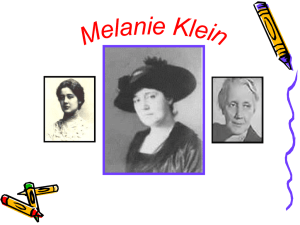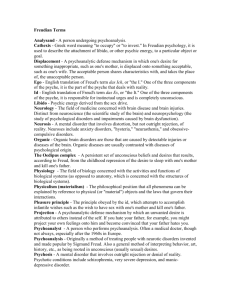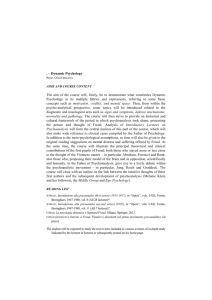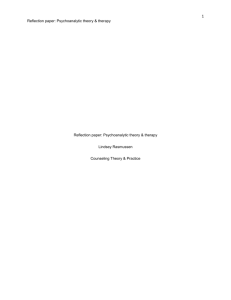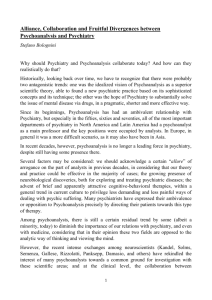Psychodynamics and psychiatry - International Psychoanalytical
advertisement
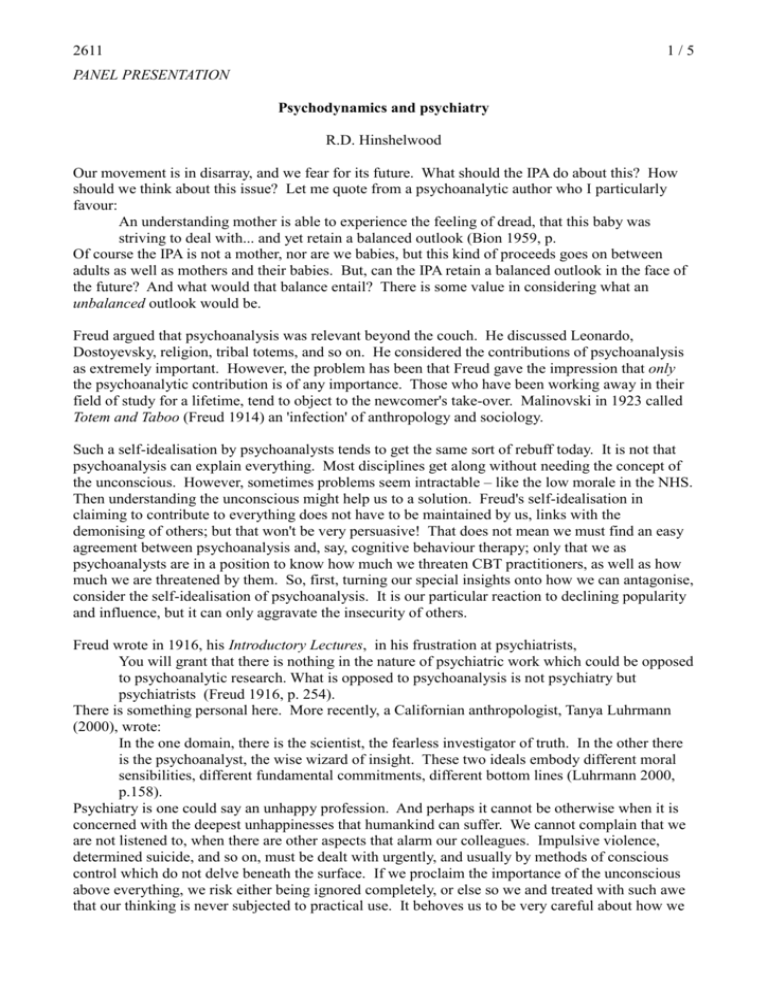
2611 1/5 PANEL PRESENTATION Psychodynamics and psychiatry R.D. Hinshelwood Our movement is in disarray, and we fear for its future. What should the IPA do about this? How should we think about this issue? Let me quote from a psychoanalytic author who I particularly favour: An understanding mother is able to experience the feeling of dread, that this baby was striving to deal with... and yet retain a balanced outlook (Bion 1959, p. Of course the IPA is not a mother, nor are we babies, but this kind of proceeds goes on between adults as well as mothers and their babies. But, can the IPA retain a balanced outlook in the face of the future? And what would that balance entail? There is some value in considering what an unbalanced outlook would be. Freud argued that psychoanalysis was relevant beyond the couch. He discussed Leonardo, Dostoyevsky, religion, tribal totems, and so on. He considered the contributions of psychoanalysis as extremely important. However, the problem has been that Freud gave the impression that only the psychoanalytic contribution is of any importance. Those who have been working away in their field of study for a lifetime, tend to object to the newcomer's take-over. Malinovski in 1923 called Totem and Taboo (Freud 1914) an 'infection' of anthropology and sociology. Such a self-idealisation by psychoanalysts tends to get the same sort of rebuff today. It is not that psychoanalysis can explain everything. Most disciplines get along without needing the concept of the unconscious. However, sometimes problems seem intractable – like the low morale in the NHS. Then understanding the unconscious might help us to a solution. Freud's self-idealisation in claiming to contribute to everything does not have to be maintained by us, links with the demonising of others; but that won't be very persuasive! That does not mean we must find an easy agreement between psychoanalysis and, say, cognitive behaviour therapy; only that we as psychoanalysts are in a position to know how much we threaten CBT practitioners, as well as how much we are threatened by them. So, first, turning our special insights onto how we can antagonise, consider the self-idealisation of psychoanalysis. It is our particular reaction to declining popularity and influence, but it can only aggravate the insecurity of others. Freud wrote in 1916, his Introductory Lectures, in his frustration at psychiatrists, You will grant that there is nothing in the nature of psychiatric work which could be opposed to psychoanalytic research. What is opposed to psychoanalysis is not psychiatry but psychiatrists (Freud 1916, p. 254). There is something personal here. More recently, a Californian anthropologist, Tanya Luhrmann (2000), wrote: In the one domain, there is the scientist, the fearless investigator of truth. In the other there is the psychoanalyst, the wise wizard of insight. These two ideals embody different moral sensibilities, different fundamental commitments, different bottom lines (Luhrmann 2000, p.158). Psychiatry is one could say an unhappy profession. And perhaps it cannot be otherwise when it is concerned with the deepest unhappinesses that humankind can suffer. We cannot complain that we are not listened to, when there are other aspects that alarm our colleagues. Impulsive violence, determined suicide, and so on, must be dealt with urgently, and usually by methods of conscious control which do not delve beneath the surface. If we proclaim the importance of the unconscious above everything, we risk either being ignored completely, or else so we and treated with such awe that our thinking is never subjected to practical use. It behoves us to be very careful about how we 2611 2/5 contribute, as psychoanalysts, to the treatment of a patient. How do we convince our colleagues – psychiatrists, nurses, and lay managers to turn to us, when it is necessary? I spent nearly 20 years, working in a psychiatric service, and wondering what one can do. My Department was a small psychotherapy service, for outpatients, local to the hospital, and for nonpsychotic people. But as far as the colleagues were concerned, I established three main areas of work which, I hoped, would influence people. These areas were (a) education and professional discussion, (b) experiential, and (c) organisational dynamics. 1. Education and professional discussion There was some thirst amongst many of the staff for a psychodynamic alternative to the largely routine treatment methods of general psychiatry. I offered consultations, but I realised that I came to be seen by some of these staff in a unique way, an enlightening alternative, in opposition to standard psychiatry. These staff included a few nurses, none of the psychiatrists, but a lot of the trainee psychiatrists, and many of the other professionals, like art and music therapists. I also taught medical students many of whom appeared fascinated by the tales of the unconscious which I told them. They came for 6-week placements, often looking for ideas that might give them personal help. Trainee psychiatrists were expected to have a minimal acquaintance with psychotherapy. Although their interest gradually changed as they passed through their training period, many did respond with a seriously interest, but, in their examinations, psychotherapy did not come up much. So their attention was increasingly absorbed in diagnostic matters, and pharmacological treatments. Nevertheless, I took a lot of interest in them as the future leaders of the profession. So, I spent some time thinking about how to develop their interest. I realised it was not so much that they needed to develop an interest, but the opposite. It appeared to me, as I compared medical students, trainee psychiatrists and my trained colleagues, that what happened in the course of this professional development was that there was a gradual movement away from taking a personal interest in the individual person of each patient. Medical students were mostly very interested, even fascinated. Trainee psychiatrists were gradually pulled away, because of exams etc., to study organic, pharmacological psychiatry based on diagnostic classification. By the time they became seniors, Consultants in the NHS, they were partially burned out. My efforts were therefore to work in the opposite direction and encourage staff, especially the young ones, to retain the fascination that they had started with. I wanted to stop as much as possible the discouragement of empathy and humanity that occurs in the course of a psychiatric career. 2. Experiential I instituted other modes of training. One was 'experiential'. First of all, I ran a study group for trainee psychiatrists. It was not group therapy, but the kind of study group that I believe Bion intended originally – to study oneself in the context of a group, for purposes of understanding what groups do to people's experience and behaviour, to discover how people are when together, and how culture develops and myths become socially constructed. The study groups were weekly, lasting 6 months, and were reconstituted every 6 months. Sometimes keen people stayed for several of these 6-month periods. I found that a considerable proportion of the psychiatric trainees took part in these experiential groups. My observations were that the group found certain kinds of problems, and I shall briefly mention them. These were: • conflict over being too like a patient 2611 3/5 • a need to retreat from danger, as if the group was safe, and must be kept separate from the work • the insecurity of being a doctor, and the 'superiority' of the study group as a group of doctors. These were purely my own impressions, and I do not claim this as a reliable piece of research. The point was to help the study group members try to work at locating what their experiences were in their role, how these experiences developed as group phenomena, and where they came from. Another experiential opportunity was to offer trainees the opportunity to make a formal observation of a ward. The aim was to help the trainees to keep focussing on their own reactions. I based this idea on the baby observation course in my own psychoanalytic training at the British Institute. The purpose in my training was to develop the ability to observe a social context – the mother with her baby and sometimes in the midst of a family. It was intended as a method of developing one's own capacity for observing emotionally, and at the same time observe oneself in the context of an emotional setting. Instead of observing a baby, the trainees observed a ward (Hinshelwood and Skogstad 2000). They picked a ward, not one they worked on, and sought permission from the nursing staff. Then they went without their stethoscopes, white coats and the emblems of official medical authority, and simply sat in one place for one hour every week for 3 months. As you see, it was aimed at helping them retain their human sensitivity without the expectation of roles in the working situation. A weekly seminar of three or four trainees met with me to discuss in a formal way their observations. I was astonished at the interest in doing this. Perhaps as many as 50% of trainee psychiatrists did this kind of observation. Some of course were better than others – but that is not the point – I wished to help them each to practice locating in themselves their experience in their working environment. The aim, of course was to try to help them to resist the blanking out of the feelings which became the characteristic development of psychiatrists as they moved towards becoming qualified for senior posts. I might say, there was on the whole a considerable enthusiasm in the ward staff as well. They accepted the observers. It was as if they were starved of interest in their ward and felt forgotten most of the time. So, they welcomed someone coming to see what happened. 3. Organisational dynamics Well, as I say, training is an institutional process, in any psychiatric service. And in any discipline. The mental health worker blanks off his feelings when in the context of his work (Hinshelwood 1999, 2004). He is encouraged to focus on 'remote aetiology', as Freud put it. Inevitably, people behave according to what the culture requires, and Freud quoted Gustav LeBon, Whoever be the individuals that comprise it, however like or unlike be their mode of life, their occupation, their character, or their intelligence, the fact that they have been transformed into a group puts them in possession of a sort of collective mind which makes them feel, think, and act in a manner quite different from that in which each individual of them would feel, think, and act were he in a state of isolation (Lebon 1895, quoted in Freud 1921, p. 73). We are different when we are in a group compared with when we are separate individuals. It is an extremely important observation. We are different when we get together – we should not forget it. But we always do forget it. And we represent group ideas and group beliefs as if they were our own. Of course they are our own, but only while we are in that group ! The psychoanalyst's job is also to negotiate a role with the organisation. I did try to understand what was going on around me, and what sort of character of a psychoanalyst was being constructed by the organisation. So let me briefly summarise: 2611 • • • • 4/5 One important aspects was that I did not have beds, as my colleagues did, and so no money, and no power – but also no threat to anyone. Then I was politely left to do my own job without much interest, as if a side-line to the real work. I was someone to provide discussion for staff who were not competently trained in the scientific stuff. I could as one colleague put it explicitly, 'keep the children happy'. At the same time my views seemed rather subversive, and I represented an organisational rift between the dominant scientific 'investigators of truth', and the 'wise wizard's of insight'. This was the most difficult issue – potentially supporting the subversive, and allowing a manageable conflict in public discussion. Because of my interest, I wrote a series of papers whilst I was there (Hinshelwood 1979, 1987, 1998**). I have to say the papers were mostly given to conferences of psychotherapists and psychoanalysts. My central point was that the rather emotionally bleached, depersonalised attitudes of psychiatrists, nurses, and others, is a form of defence against the stress of the work. What is that stress? • First of all, staff fear potential violence which has to be controlled, and the psychiatrist is the final resource for controlling it. But patients also fear the violence – from each other, and from the more brutal forms of treatment and control. • Second, psychiatry must deal with a quality of meaninglessness. It pervades the communications and behaviour of patients, and it is deeply disturbing for staff to tolerate the lack of meaning in patients' utterances and behaviour. • And third, our work is not always successful in restoring our patients back to health, a fact that gives us only a partial reward. Moreover, the patients disorders leave them with little appreciation or gratitude to us (compared perhaps with surgical of obstetric patients). All these difficulties come together to make us often feel overwhelmed, in a service which continually takes in suffering and disturbance. Under those stresses, the response is to retreat to an emotional distance. It gives some relief for staff, but it leaves the patient as if an inanimate object. This then becomes institutionalised as a scientific attitude, something I believe that phramaceutical companies play on (Hinshelwood 1999). We, as psychoanalysts who represent keeping close personal contacts, unwittingly challenge the institutional defence of all the mental health professions. In my own experience I have explored ways in which we can support colleagues in sustaining their capacities for human contact with each other and their patients. In conclusion, I am describing a need for a negotiated acceptance. Inevitably this must be to some extent on the terms of the organisations and its culture. It gave me sense of how troubled organisations must divide into a dominant culture and an anti-culture. It seems important always to recognise the potential to be subversive, that threatens the insecure organisation, rather than supports a constructive influence. References Bion, W. R. (1959) Attacks on linking, International Journal of Psychoanalysis, 40, 308-315. Reprinted in Bion, W.R. (1967) Second Thoughts. New York: Jason Aronson; pp. 93-109. Freud, S. (1913) Totem and Taboo. The Standard Edition of the Complete Psychological Works of Sigmund Freud, Volume XIII. London: Hogarth, pp. 1-162. Freud, Sigmund, (1916-17 ) Introductory Lectures on Psycho-Analysis.. Standard Edition of the Complete Psychological works of Sigmund Freud, Volume 15-16. London: Hogarth. Freud, S. (1921) Group Psychology and the Analysis of the Ego. The Standard Edition of the 2611 5/5 Complete Psychological Works of Sigmund Freud, Volume XVIII. London: Hogarth, pp. 65144. Hinshelwood, R.D. (1979) Demoralisation in the hospital community. Group-Analysis 11: 84-93. Hinshelwood, R.D. (1987) The psychotherapist's role in a large mental institution. Psychoanalytic Psychotherapy 2: 207-215 Hinshelwood, R.D. (1998) Creatures of each other: some historical considerations of responsibility and care and some present undercurrents, Angela Foster and Vega Roberts (eds) Managing Mental Health in the Community: Chaos and Containment in Community Care. London: Routledge. Hinshelwood, R.D. (1999) The difficult patient: the role of ‘scientific’ psychiatry in understanding patients with chronic schizophrenia or severe personality disorder. British Journal of Psychiatry 174: 187-190. Hinshelwood, R.D. and Skogstad, W. (2000) Observing Organisations. London: Routledge, Hinshelwood, R.D. (2004) Hinshelwood, R.D. (2004) Suffering Insanity: Three Psychoanalytic Essays on Psychosis. (London: Routledge). LeBon, Gustav (1895) Psychologie des foules. Paris: Alcan. English translation, (1995) as The Crowd. Brunswick (US) and London (UK): Transaction Publishers. Luhrmann, T. (2000) Of Two Minds. New York: Alfred Knopf. Malinowski, Bronislav (1923) Psychoanalysis and anthropology. Nature 112: 650-651.


